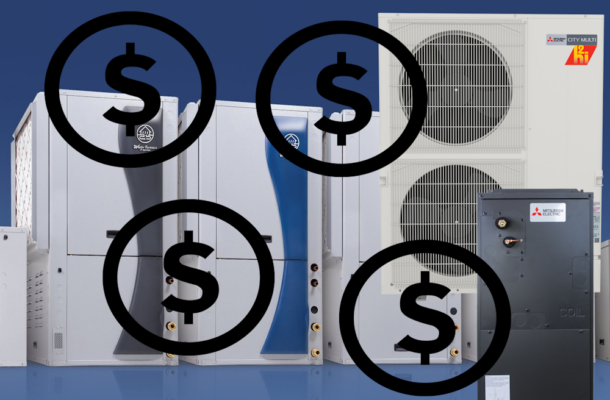Geothermal (ground-source) vs air-source heat pump ROI

There are many factors that make determining return on investment for something as complicated and unique as a home’s HVAC system difficult. I was looking forward to this video from Matt because I knew that he had opted for a Water Furnace ground-source (aka geothermal) heat pump setup. We’re opting for air-source for our passive house, probably a Mitsubishi Hyper-Heat with a ducted internal configuration. It was great to see him show his hand, but after looking at the numbers, which frankly are a little odd, it is really hard to understand how he got to the conclusion that geothermal is the better choice, even for him.
Even though I have some questions about his numbers, let’s use them, but adjusting for the $2,000 federal tax credit that was footnoted, but not included in the original discussion. After the 30% tax credit for geothermal, Matt will have paid $54,600 for the ground-source system. He was quoted $36,000 ($38,000-$2,000) for a comparable air-source heat pump system. So the difference is $18,600. He claims that the difference in cost per year between the two systems will be ~$1,000. That seems crazy large given the efficiency differences I’ve seen between ground-source and air-source, but like I said we’re running with his numbers. Easy math there, 18.6 years for him to “break even” against the air-source system. That’s a long time.
Let’s say that we take that $18,600 and put it somewhere that earns 5% a year. This is easy right now, just put it in the bank. S&P return for the last 20 years is ~10%. In 18 years at 5%, we’ll have $45,663 in the bank, and Matt’s just breaking even. Except he’s probably not, because he probably financed that $18,600 in his mortgage. What’s the going rate for a 30-year mortgage right now, 8%?
Let’s say we don’t really care about the nerdy financial stuff, and we take that $18,600 and use it to buy solar panels. Over that 18.6 year period, there’s a good chance given PV ROI that we’re well in the green with electricity generation as well. Given the rates Matt pays where he lives (IIRC, he’s mentioned ~$0.34kWh), that’s also a lot of money. Maybe his well above national average (~$0.12kWh) pricing is how he gets to $1,000/year?
I totally understand that this is a rabbit hole that is problematic for me to climb down as well, because similar arguments could apply to the money we’re spending on our passive house project (I don’t even like to think about that :D). But, we do have to live somewhere, and our projected cost (not including PV ROI) should end up not that far off of what our current house is worth. So while this is very much an ideological project for us, we’re not ignoring the financial aspects either. Which is where geothermal really struggles, the ROI just isn’t there if actually do the math.

Now a days the average year round efficiency difference between air source and geothermal heat pumps is almost the same. Unfortunately everything I have seen and recommended for installing always has the geothermal costing significantly more. It is just not cheap to drill the wells, equipment costs are almost the same. Where it does make sense to do geothermal is in really cold climates. Those hyper heat units work great down 0F (keeping almost 100% of there capacity) but if you have temps that get below that for a significant amount time they won’t work. I think the hyperheats will work down to -13f, but not at full capacity. An example is Denver. We don’t get to many days below zero, but last year we had 4 days in a row that didn’t get above -1F. So that is where geothermal would have worked out better since it isn’t effected by the cold.
Yep, Hyper-Heat claims full function (at efficiency cost) down to -13F. We plan to put in heat strips (100% efficient resistive heating) for the days that get below that. In Chicago we get ~4 days a year below 0F. Even though the system won’t be operating at an efficiency multiplier when the heat strips are running, I think the financials still come out massively in favor of an ASHP. The drilling cost for a vertical well (what we would need to do), kills the ROI for us just like it did for Matt. Especially because on those really cold days we usually get great sun, so the PV should be working hard :D.
If you can do a horizontal loop, then it might make sense. Those should be much cheaper. I haven’t priced out what horizontal would cost because it’s not an option unless you’re building on a large plot of land. It will be interesting to see how this market develops over the next few years. I suspect that long term the cost/volume advantage of ASHP will suck all the research towards it. We’ve already kind of seen this trend.